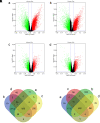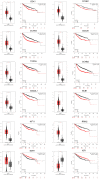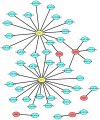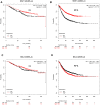Construction of an mRNA-miRNA-lncRNA network prognostic for triple-negative breast cancer
- PMID: 33428596
- PMCID: PMC7835059
- DOI: 10.18632/aging.202254
Construction of an mRNA-miRNA-lncRNA network prognostic for triple-negative breast cancer
Abstract
The aim of this study was to establish a novel competing endogenous RNA (ceRNA) network able to predict prognosis in patients with triple-negative breast cancer (TNBC). Differential gene expression analysis was performed using the GEO2R tool. Enrichr and STRING were used to conduct protein-protein interaction and pathway enrichment analyses, respectively. Upstream lncRNAs and miRNAs were identified using miRNet and mirTarBase, respectively. Prognostic values, expression, and correlational relationships of mRNAs, lncRNAs, and miRNAs were examined using GEPIA, starBase, and Kaplan-Meier plotter. It total, 860 upregulated and 622 downregulated differentially expressed mRNAs were identified in TNBC. Ten overexpressed and two underexpressed hub genes were screened. Next, 10 key miRNAs upstream of these key hub genes were predicted, of which six upregulated miRNAs were significantly associated with poor prognosis and four downregulated miRNAs were associated with good prognosis in TNBC. NEAT1 and MAL2 were selected as key lncRNAs. An mRNA-miRNA-lncRNA network in TNBC was constructed. Thus, we successfully established a novel mRNA-miRNA-lncRNA regulatory network, each component of which is prognostic for TNBC.
Keywords: biomarker; competing endogenous RNA; prognosis; triple-negative breast cancer.
Conflict of interest statement
Figures







Similar articles
-
A novel mRNA-miRNA-lncRNA competing endogenous RNA triple sub-network associated with prognosis of pancreatic cancer.Aging (Albany NY). 2019 May 6;11(9):2610-2627. doi: 10.18632/aging.101933. Aging (Albany NY). 2019. PMID: 31061236 Free PMC article.
-
Comprehensive Analysis of Differentially Expressed Profiles of lncRNAs/mRNAs and miRNAs with Associated ceRNA Networks in Triple-Negative Breast Cancer.Cell Physiol Biochem. 2018;50(2):473-488. doi: 10.1159/000494162. Epub 2018 Oct 11. Cell Physiol Biochem. 2018. PMID: 30308479
-
Comprehensive analysis of prognostic biomarkers in lung adenocarcinoma based on aberrant lncRNA-miRNA-mRNA networks and Cox regression models.Biosci Rep. 2020 Jan 31;40(1):BSR20191554. doi: 10.1042/BSR20191554. Biosci Rep. 2020. PMID: 31950990 Free PMC article.
-
Reconstruction and Analysis of the Differentially Expressed IncRNA-miRNA-mRNA Network Based on Competitive Endogenous RNA in Hepatocellular Carcinoma.Crit Rev Eukaryot Gene Expr. 2019;29(6):539-549. doi: 10.1615/CritRevEukaryotGeneExpr.2019028740. Crit Rev Eukaryot Gene Expr. 2019. PMID: 32422009 Review.
-
Progress of non-coding RNAs in triple-negative breast cancer.Life Sci. 2021 May 1;272:119238. doi: 10.1016/j.lfs.2021.119238. Epub 2021 Feb 16. Life Sci. 2021. PMID: 33600860 Review.
Cited by
-
microRNAs expression profile in phyllodes tumors of the breast.Heliyon. 2024 Jan 18;10(2):e24803. doi: 10.1016/j.heliyon.2024.e24803. eCollection 2024 Jan 30. Heliyon. 2024. PMID: 38312609 Free PMC article.
-
Assessment of MicroRNAs Associated with Tumor Purity by Random Forest Regression.Biology (Basel). 2022 May 21;11(5):787. doi: 10.3390/biology11050787. Biology (Basel). 2022. PMID: 35625515 Free PMC article.
-
Long non-coding RNA (LncRNA) CASC9/microRNA(miR)-590-3p/sine oculis homeobox 1 (SIX1)/NF-κB axis promotes proliferation and migration in breast cancer.Bioengineered. 2021 Dec;12(1):8709-8723. doi: 10.1080/21655979.2021.1977555. Bioengineered. 2021. PMID: 34711117 Free PMC article.
-
ADAM metallopeptidase domain 12 overexpression correlates with prognosis and immune cell infiltration in clear cell renal cell carcinoma.Bioengineered. 2022 Feb;13(2):2412-2429. doi: 10.1080/21655979.2021.2010313. Bioengineered. 2022. PMID: 35094638 Free PMC article.
-
Nanomaterial-assisted CRISPR gene-engineering - A hallmark for triple-negative breast cancer therapeutics advancement.Mater Today Bio. 2022 Oct 4;16:100450. doi: 10.1016/j.mtbio.2022.100450. eCollection 2022 Dec. Mater Today Bio. 2022. PMID: 36267139 Free PMC article. Review.
References
Publication types
MeSH terms
Substances
LinkOut - more resources
Full Text Sources

